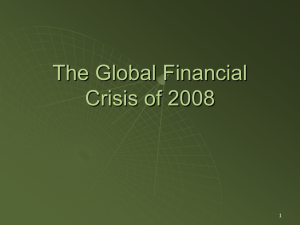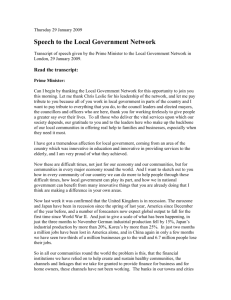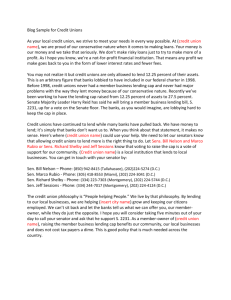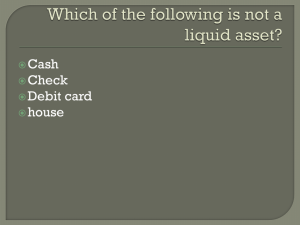The Global Economic Crisis and Alternatives to Rebuild the Economy
advertisement
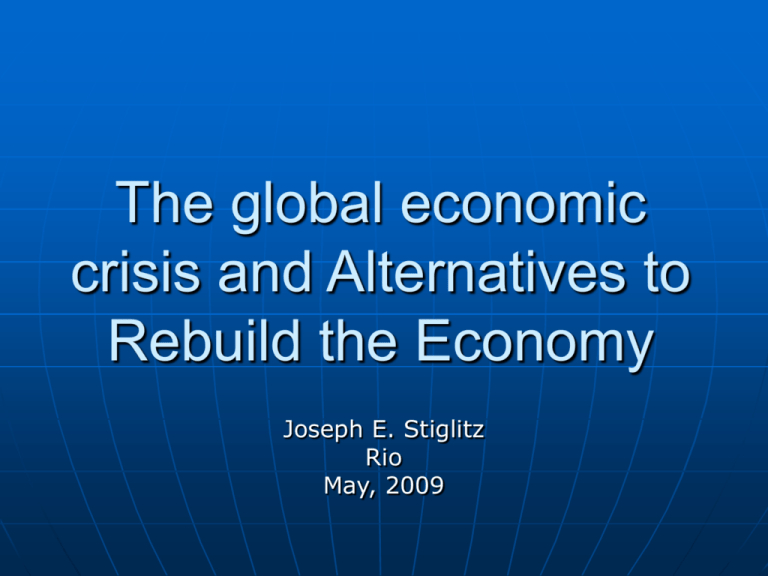
The global economic crisis and Alternatives to Rebuild the Economy Joseph E. Stiglitz Rio May, 2009 The future is bleak The most serious economic disturbance since Great Depression • Most downturns since have been inventory cycles Economy recovers as soon as excess inventories are decumulated • Or a result of Central Bank stepping on brakes too hard Economy recovers as soon as Central Bank discovers its mistake, removes its foot from brake • This economic downturn is a result of major financial mistakes Akin in many ways to frequent financial crises in developing countries America’s economy has been sustained by consumption boom, fueled by a housing bubble • Savings fell to zero • That game is over • Posing a global problem: America’s consumption boom sustained the global economy The storm is just beginning • Rising unemployment • More foreclosures, as house prices continue to fall 3.6 million so far, 2 million expected in next year 12 million mortgages underwater and numbers rising • Credit constraints likely to persist—poorly designed bailout • Shouldn’t confuse end of free fall, or even slight recovery from bottom, with the beginnings of a robust recovery Each of components of aggregate demand weakening States and localities cutting back Households likely to increase savings substantially • May be good in short run, but “paradox of thrift” means that national income will be reduced • Restraints on ability and willingness to borrow Loss in wealth Had been borrowing on assumption of rising house prices Investment likely to slow • Real estate has been main source of investment— declining at record levels (overbuilding) • Other firms face credit constraints, uncertainty, declining sales Exports have been major source of demand • But dollar is strengthening • And downturn is spreading A Vicious Cycle Weak economy, higher unemployment More foreclosures, more bad loans, weaker banking system, more restricted lending Lower prices for housing, reduced consumption, weaker economy Becoming a global slowdown Myth of decoupling Effects spreading to Europe • Partly because of major financial losses in Europe • Including in Eastern Europe • Partly because of exchange rate adjustments, impact on exports • Both part of globalization Now spread to China, India, Brazil • Even countries that did not make any of the mistakes that the U.S. did, had good regulatory and monetary policies Will affect most countries • Through effects on global financial markets Highly indebted countries, with large trade deficits, likely to be most affected Also through investment Financial market protectionism • Through prices of commodities • Through trade • Through remittances “Periphery” likely to be greatly affected Heavy dependence on exports • • • • Declines in exports Partly explained by Partly explained by Partly explained by investment greater than anticipated lack of trade credit inventory adjustment large fall of demand for durables, Heavy dependence on foreign direct investment Heavy dependence on foreign borrowing Some with heavy dependence on remittances Less resources to combat downturn and its effects Even countries with “good” economic policies are being affected Irony: money is flowing back to US • Even though it was source of problem • Because of relative confidence in US government guarantee Brazil is in a Good Position Monetary policy has given it room to maneuver— • Unlike the U.S. • Which has been forced to engage in risky strategies, with uncertain long term consequences • And little short run impacts—other than preventing the crisis from going into freefall But will be important to use all available instruments As large economy, more room for effective stimulus spending BROAD GENERAL LESSONS Need to rethink what are “good” policies and institutions • Most would have thought that the U.S. had good policies and institutions Evidently not Problems are pervasive and deep-seated So question is: What are good policies and institutions? • Deregulatory policies of U.S. were similar to those advocated under Washington Consensus by IMF and U.S. Treasury September 15: A Watershed The fall of the Berlin Wall marked the end of Communism and the belief in that economic system The massive bail-outs in the US marked the end of market fundamentalism, belief in unfettered markets • Markets are not self-adjusting, self-correcting • At least in the relevant time frame • America’s response is being called “Socialism with American Characteristics” America’s financial markets have failed and failed massively Supposed to mobilize savings, allocate capital, manage risk Didn’t mobilize savings: encouraged living on credit card Misallocated capital Created risk But failed to create products that would help ordinary American households and firms manage the risks which they faced High transactions costs—and resisted creating an efficient Electronic Payments Mechanism Underlying market failures Underlying problem: Lack of congruence between social returns and private rewards Net return 2004 to date negative Incentive systems • Encouraged excessive risk taking, myopic behavior • Encouraged lack of transparency, greater complexity Lack of transparency, excessive complexity • Underlying cause of credit crunch Too big to fail—encouraged excessive risk taking Underlying problems in corporate governance Rating Agencies Believed in financial alchemy—could convert F rated subprime mortgages into A rated securities safe enough for pension funds; played an essential role in securitization process Played key role: facilitated flow of funds into bad lending Conflicts of interest—paid by those they rated Competition made it worse: race to the bottom Failed to assess risks accurately—flawed models • Underestimated correlations, likelihood of small probability events, risk of price declines • Reinforced mistakes of the banks • Failures were predictable and predicted Not for the first time (also failed in East Asia crisis) Securitization Allowed greater diversification of risk and risk spreading But created new asymmetries of information Incentives for lower quality of lending Banks and rating agencies failed to take into account the effects of new asymmetries of information and new risky products on foreclosure rates Derivatives, CDS, and other risky products Double-edged sword Could help manage risk But also could be used as new high power gambling instrument Contributed to lack of transparency Which in turn contributed to credit crisis Risk recognized Fight over regulation in the 90s • Financial markets won short-run battle • They, the American economy, and the world lost in the long run Underlying public failures Macro - excessive liquidity, low interest rate • Partially in response to breaking of tech bubble, soaring oil prices Followed example of Latin America in the 70s • Should have designed better fiscal policies • But cheap credit should be a “good thing”—basis of rapid growth, if well used—real problem with financial markets and regulation Deregulation, failure to enforce existing regulation, to adopt new regulations to respond to changing financial landscape • Deregulation philosophy • Regulators who didn’t believe in regulation Loose money and lax regulations were an explosive mixture Failure to enforce competition laws contributed to “too big to fail” Flawed bail-out Non-transparent, unaccountable Cash for trash could not be done quickly Is it enough? • We don’t know—banks too non-transparent • But what would have been enough one month ago is not enough today • Bail-outs getting larger and larger—to little effect • But exposing taxpayers to increasing risk • Massive blood transfusion to a patient suffering from internal hemorrhaging Finally beginning to do something But not enough—need write down of principle • Need to address real economy Stimulus not enough Badly designed Flawed bail-out Will it ensure resumption of lending? • Probably not • Didn’t stop banks from distributing money to shareholders, even as government was pumping money in (contrast with U.K.) • Didn’t provide adequate oversight (contrast with U.K.) Flawed bail-out Will it restore confidence? • Probably only to a limited extent • No change in those in charge (contrast to U.K.), no sense of accountability • So far, no change in regulations and regulatory structures Worry about “cosmetic reform” • Increase in guarantees helpful, but still insufficient Flawed bail-out Did the taxpayer get a good deal? • One question for which there is a clear answer—taxpayers got a raw deal Prices of shares after announcement Pricing of preferred shares, terms Contrast with Buffett, U.K. Congressional Oversight Panel—taxpayers badly cheated More recent bail-outs worse CBO estimates massive losses • Important: growing national debt will make taking appropriate actions more and more difficult The result… Economic downturn will be longer and deeper than it otherwise would have been And America’s national debt will be much larger than it otherwise would have been Both will have global consequences Incipient controversies Second round of a stimulus? • Size of national debt may impose constraints • Before economy is on robust recovery • Irony: worries about size of deficit likely to come from financial sector, but only after they have had their bail-out Incipient Controversies How extensive should bail-outs be? And under what terms? • Government could have resuscitated economy much more effectively with less money by creating new institutions, rather than saving old institutions Debate reminiscent of debates in the economies in transition • What is best way to save old institutions? Bankruptcy (especially chapter 11) simply changes management and financial claims; real assets don’t disappear Are we bailing out auto industry, or Wall Street bondholders? Confusing saving banks with saving bankers, bondholders, and shareholders Debt to equity swaps would enhance financial stability, confidence Incipient controversies How extensive should the regulations be? • Some worry that the pendulum will swing too far, innovation will be stifled • But most of innovation was involved in regulatory, accounting, and tax arbitrage, had little social value Little innovation to help ordinary Americans manage the important risks they face (stay in their own homes) • Good regulation may actually enhance “good” innovation and contribute to a more productive economy Incipient Controversies Who should pay for the bail-outs of the financial sector? • Originally, they claimed the bail-outs would pay for themselves • As size has increased, likelihood has decreased • Current estimates are very large losses • Some suggest making them pay would discourage attracting private capital • Others argue matter of efficiency and equity Similar to polluter pays principle in environmental economics Big Questions Today Where is economy going? Will proposed stimulus and bank bail-out work? And what will things be like at the other end? Growing consensus • Even large stimulus not likely to make up for shortfall in aggregate demand • Unless something dramatic is done, when we emerge from recession, likely to emerge into “malaise” rather than into strong growth What is to be done? Problem is global, not just American • America has been the source of global aggregate demand Alternative sources of increased aggregate demand 1. Redistribution—offsetting marked increased inequality in recent years 2. Responding to the needs of global warming—huge investments required 3. Reforming the global financial system—new global reserve system, annual creation of SDR’s 4. Assistance to developing countries Don’t have resources for stimulus, protect banks, provide safety net Lessons for other countries Washington Consensus model didn’t even work in Washington • We are all Keynesians now But not all Keynesians are the same Keynesian economics can be abused and used for special interests, just as any other economic doctrine • We will be redesigning our corporate governance and regulatory systems There will be resistance from those who benefited from old system Lessons for other countries Design regulatory structures assuming that others are not doing their job • Ring-fence core financial system • Regulation has to be comprehensive Little point in having transparency in just a part of the system • Host country has to play central role in regulation Need strong consumer protection, anti-trust, safety and soundness, and access regulations • Speed limits • Consumer protection • Worse lending combined risky and predatory lending • Key function of finance is to provide credit, especially to small and medium sized firms CRA requirements to encourage finance to underserved groups, imposed on all Rethinking Monetary Policy Stability is necessary for growth • But price stability is not the only aspect of stability • Excessive focus on price stability part of key mistake of Central Banks around the world • Need to focus more on financial stability New global landscape Problem was “made in America,” and so far, America’s political system’s response to crisis has been disappointing • Even in contrast to “old Europe” America is still largest economy • But America is no longer largest source of savings • America has lost dominance in manufacturing • America may now lose pre-eminence in financial markets Role in financial intermediation based on presumption of “better institutions,” comparative advantage in managing risk and allocating capital Latin America, Africa increasingly turning to China as a source of finance New Global Landscape Old international governance structure failed • IMF, Financial Stability Forum didn’t do much to prevent crisis Imposed large number of conditions Including counterproductive pro-cyclical macro-policies Encouraged financial sector deregulation which played such a big role in creating the crisis—and even in its propagation Encouraged capital market liberalization, which too played key role in the spread of the crisis • Led to greater risk • Without any greater growth Promoted monetary policies that didn’t pay sufficient attention to financial stability Underlying problems political and ideological • Proposed governance reforms not likely to make much difference, though steps in the right direction. • Yet they are the only institutions we have UN Commission UN Commission emphasizing need for additional funds and recommending: • • • • new new new new credit facilities global regulatory authority, global economic coordinating council global reserve system Key to restoring global aggregate demand Institutions created in first half of 20th century not up to tasks of 21st century • And many have a legacy of pushing failed ideology that may impair effectiveness BIG QUESTIONS AHEAD What kind of financial system do we want when the economy emerges from crisis? • Can’t, shouldn’t go back to pre-crisis structure • Recovery strategy should be based on long term vision Bail-outs have reinforced old problems, money disproportionately going to too big to fail institutions BIG QUESTIONS AHEAD Crisis is forcing rethinking about what kind of society, economy works best • Need to get the balance between the market and the government (and other non-state actors) right • Markets were unstable, inefficient, exploitive They discovered there was money at the bottom of the pyramid and did everything they could to make sure it didn’t remain there Silver lining on this cloud: Societies all over the world are beginning to rethink
